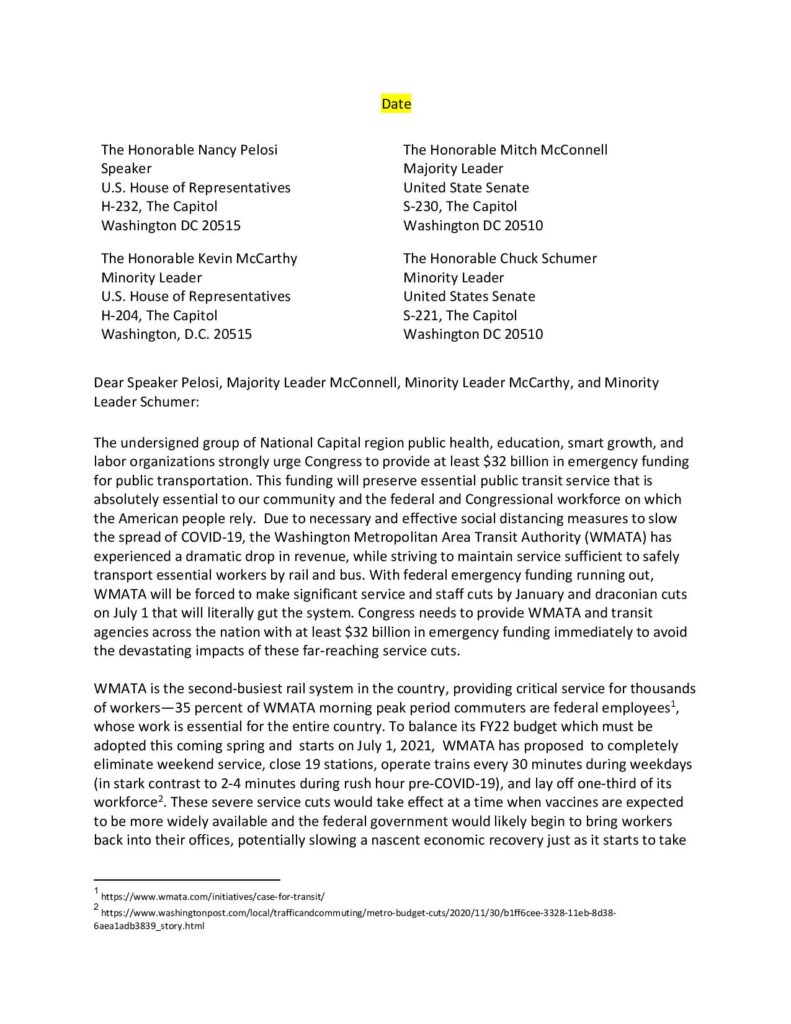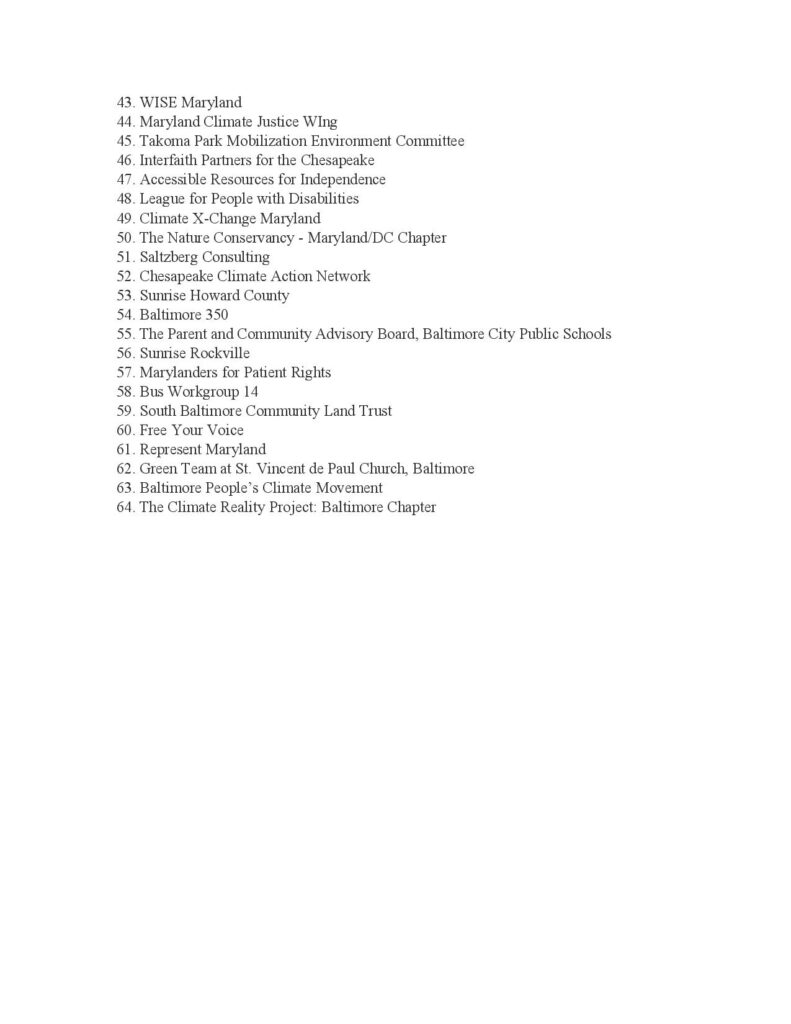Category: Better Public Transit
RELEASE: Campaign for better buses in Mont. Co. launches at noon, 25+ orgs support
Today, over 25 organizations will launch a campaign advocating for better bus service in Montgomery County.
MEDIA ADVISORY: 20+ organizations to announce campaign to reimagine bus service in Montgomery County
Over 20 organizations will hold an event to launch a campaign for better Ride On and Metrobus service in Montgomery County.
RELEASE: “Devastating. Leaders must step up to save WMATA.”
PRESS STATEMENT
December 1, 2020
Contact:
Stewart Schwartz, Executive Director
703-599-6437 (cell)
Proposed cuts to WMATA would be devastating
Leaders must step up!
“The reality of proposed cuts to our Metrorail and Metrobus service in the absence of a rescue package is now clear. It would be simply devastating – to our workers, our economy, our transportation network.
Congress needs to step up and this includes every Republican. We are one nation, one economy, with a huge share of our economy dependent on our cities and metropolitan regions.
If the cuts were to take place they would gut a system the DC region built over four decades and upon which our essential workers and economy depends. It would undermine decades of real estate investment, prompt flight of our next generation workforce, and have a disproportionate impact on the essential workers upon whom our food and health and services systems depend.
We shouldn’t let our two Governors and local elected officials off the hook either. We cannot afford to continue wasteful road expansion and sprawl, massive toll roads that benefit few, and boondoggles like the Maglev when we can’t afford to maintain and operate what we’ve already built. We must be shifting funding from road expansion to save the transit system that is the backbone of our region’s economy.
‘Fix-it-first’: maintain, rehabilitate, and operate our existing infrastructure and locate new development in walkable communities with both jobs and frequent transit.”
###
MetroNow Emergency Transit Funding Sign-on Letter
Dear Members of the Congressional Delegation for Maryland, the District of Columbia and Virginia:
Transit is a lifeline for essential workers and critical to our economic health and well-being. The CARES Act, passed in March of this year, provided a stop gap to help transit agencies survive dramatic losses in revenue streams, unprecedented drops in ridership, and fund new and enhanced cleaning protocols, but the funding is running out. Transit agencies nationally need $32 billion in emergency operating funds to avoid damaging service and jobs cuts and minimize economic hardship.
The vast majority of WMATA funding comes from capital contributions, jurisdictional subsidies, and farebox revenues from riders. Since COVID-related restrictions were enacted in March, farebox revenues have evaporated. Bus fares were waived around the Capital Region to minimize interaction between rider and driver, and Metrorail, which kept fares intact, has averaged only about 10% of the pre-COVID ridership since March. In Maryland, the Transportation Trust Fund relies largely on motor fuel taxes, titling and registration fees, federal aid, sales tax, transit fares, and port and airport fees, all of which have taken a hit during the pandemic, with corresponding impacts to the Maryland Transit Administration (MTA). Meanwhile, as jurisdictions face the worst fiscal crisis in living memory, they are stripping budgets to the bones, leaving no room to alleviate losses in farebox revenue through additional jurisdictional subsidies.
When the CARES Act funding runs out, transit agencies will be forced to cut transit service and furlough or lay off workers or redistribute capital funds, intended for repairs and expansion, to operating budgets. Both options will seriously harm the viability, safety, and reliability of transit service in the short and long term, but more importantly, it will harm the riders, businesses, and regional economies and workers that depend on transit. Anticipating the lack of federal aid, WMATA and the Maryland Transit Administration have already warned of service and workforce cuts to address their COVID-19 revenue impacts. Cuts to transit will harm the region, weaken the economic recovery, slash capital expenditures and the jobs they support, and worsen inequality.
The economy cannot recover without transit. If Congress fails to act this month to fund $32 billion in emergency operating funds, it will deepen the economic pain already felt by millions throughout the country. In this time of uncertainty, grief, and loss, Congress must put aside their differences and work together to fund transit or this region will emerge weaker on the other side of the virus.
The undersigned business groups, transit agencies, unions and elected officials urge you to commit this critically needed funding for transit. Our riders, our economy, and our region depend on it.

Keep transit moving by wearing a mask!
Public transit has been a lifeline for essential workers who keep our society and economy moving. Meanwhile, recent reports indicate that masks work to keep people safe. Reports from countries like Japan and France suggest that public transit is relatively safe, so long as passengers wear masks, don’t talk, maintain distance, and agencies maintain regular cleaning.
Click here for a great graphic from the Mayo Clinic on which masks work and which don’t. Avoid N95 masks with vents, as they do not prevent virus transmission. See below for how to correctly wear a mask.

All transit agencies in the DC region require masks. WMATA and Ride On both offer disposable masks and hand sanitizer to riders free of cost, but please do your best to remember your own mask!
By wearing a mask, you will be protecting your fellow passengers, your transit operators, and yourself! As the CDC’s Dr. Robert Redfield recently announced, transmission will decrease sharply if we can all commit to wearing a mask for the foreseeable future.
We know, masks aren’t always comfortable, especially in the hot summer months in the DC area, but masking up is a relatively easy way to make a positive impact in your community and keep transit moving. So wear your mask, travel with hand sanitizer, and please continue to stay safe and healthy. We will get through this together!
For more information on transit safety in the age of COVID-19, check out these resources:
Bloomberg: Japan and France find public transit systems safe
NY Daily News: Transit: safe and vital to reopen
The Atlantic: Fear of Transit is Bad for Cities
Keep transit moving by wearing a mask!

Public transit has been a lifeline for essential workers who keep our society and economy moving. Meanwhile, recent reports indicate that masks work to keep people safe. Reports from countries like Japan and France suggest that public transit is relatively safe, so long as passengers wear masks, don’t talk, maintain distance, and agencies maintain regular cleaning.
Be sure to wear the mask correctly on your face, and avoid touching it whenever possible. Avoid N95 masks with vents, as they do not prevent virus transmission.

All transit agencies in the DC region require masks. For those in Montgomery County, Ride On buses are equipped with limited supplies of disposable masks available to riders without masks, but please do your best to bring your own!
By wearing a mask, you will be protecting your fellow passengers, your transit operators, and yourself! As CDC’s Dr. Robert Redfield recently announced, transmission will decrease sharply if we can all commit to wearing a mask for the foreseeable future.
We know, masks aren’t always comfortable, especially in the hot summer months in the DC area, but masking up is a relatively easy way to make a positive impact in your community and keep transit moving. So wear your mask, travel with hand sanitizer, and please continue to stay safe and healthy. We will get through this together!







